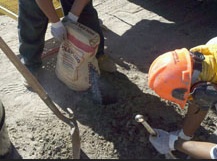Plug and abandonment procedures are performed to cap abandoned water wells and groundwater monitoring wells that no longer serve a purpose. When a groundwater monitor well or water well deteriorates or is no longer viable, the well pipe that reaches from the aquifer to the surface remains open and or sealed by a manhole. It is a direct pathway for contaminants to follow if left open or damaged. The soil contains a natural filtration system that reduces the amount of contaminants that can reach the aquifer. Wells have no such filter and become a direct path for contaminants to follow.
Why Is There A Need For Plug And Abandonment In Texas?
Water is the most valuable natural resource in Texas. Without water, ranchers could not water their cattle and residents would not have the water they need to survive. In the state of Texas alone, more than 1.5 million water wells have been drilled since 1900. Of this 1.5 million more than 500,000 have been plugged and abandoned.
More than 500,000 groundwater monitor wells have been drilled and over 80% have been plug and abandoned. There are over 1.1 million direct connections to aquifers below the earth's surface in Texas that are still potential sources of contamination if they are not properly installed and sealed at the surface wells. To protect the aquifers and maintain water quality, plug and abandonment procedures were devised to prevent runoff and surface contamination from being allowed to leach into the Texas Aquifers. Two of the most prominent aquifers in Texas are the Edwards Aquifer and the Ogallala Aquifer.
Other environmental contaminants, such as fertilizers, pesticides and other harmful chemicals can also enter the aquifers if the Groundwater Monitoring Wells and Water Wells are not capped and protected properly.
What Materials Are Used During Plug And Abandonment?
When plugging and abandoning water wells and groundwater monitoring wells , several different kinds of materials are used as wells as several Federal, State and Local Regulations that must be adhered to.
In some cases, a combination of materials may be used to ensure the Plug and Abandonment is effective and maintains structural integrity. The most popular choices to create a solid, impenetrable cap that prevents contaminated fluids from seeping into the aquifer include:
- Bentonite
- Bentonite grout
- Cement
When the plug and abandonment procedure is properly completed and permanently sealed the site is returned to pre drilling conditions. The goal is to make sure the area near the well is returned to its original state, prior to any assessments or drilling processes.
If you are interested in learning more about the plug and abandonment process, call Talon/LPE and talk to their team of environmental drilling professionals. They can describe the plug and abandonment process in detail and give you a working idea of what it entails and how it will benefit your project.

